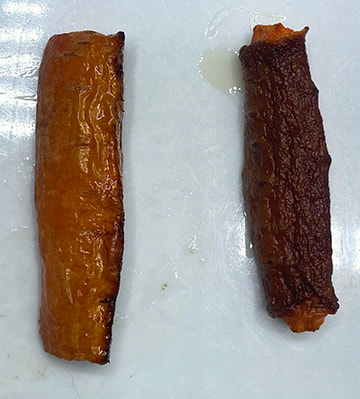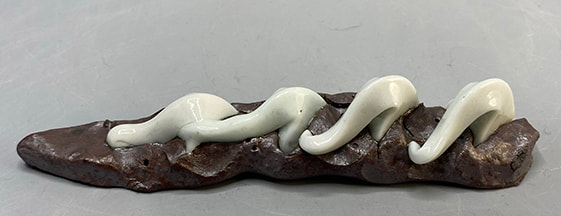Heatwork; why do ceramic artists use cones both literally and to talk about "temperature"
Heat work is the interaction of temperature AND TIME on a material. In ceramics, you can’t put a thermometer inside of the ceramic material like you can with a turkey or chicken when you’re roasting it! Cones are what we use to measure heatwork. The biggest misconception with cones is that they represent a temperature. They do not. They represent the effect of TIME AND temperature combined on a ceramic material.
Heat work is the interaction of temperature AND TIME on a material. In ceramics, you can’t put a thermometer inside of the ceramic material like you can with a turkey or chicken when you’re roasting it! Cones are what we use to measure heatwork. The biggest misconception with cones is that they represent a temperature. They do not. They represent the effect of TIME AND temperature combined on a ceramic material.
Obviously, the carrot piece on the right has had more heatwork. But asking you the temperature of the oven is a trick question; I didn’t tell you how LONG they were in the oven at that temperature! Well, the carrot at the right was baked at 200 degrees, and the carrot at the left was baked at 400 degrees. I simply kept the one baked at 200 degrees in the oven LONGER. Heatwork is not temperature alone-it is time and temperature combined acting on the material. This is why if you fire a kiln at 2,000-2,100 degrees for five or six days, you can melt, lets say cones 10 or 11, while an electric kiln that reaches over 2,200 degrees might only melt cone 6!
Obviously, the carrot piece on the right has had more heatwork. But asking you the temperature of the oven is a trick question; I didn’t tell you how LONG they were in the oven at that temperature! Well, the carrot at the right was baked at 200 degrees, and the carrot at the left was baked at 400 degrees. I simply kept the one baked at 200 degrees in the oven LONGER. Heatwork is not temperature alone-it is time and temperature combined acting on the material. This is why if you fire a kiln at 2,000-2,100 degrees for five or six days, you can melt, lets say cones 10 or 11, while an electric kiln that reaches over 2,200 degrees might only melt cone 6!
What do the numbers mean? Well, the cones are scientifically designed to measure very specific levels of heatwork. What temperatures are used to get to that level of heatwork varies with how long you take to get to top temperature, and when you get to the top temperature, do you stay there or immediately stop and let the kiln cool, or do you maintain that temperature (“soak” is the correct term for this) for what length of time. Commercially made kilns generally come with controllers that do all the figuring for us. We type in what cone we want to reach, how fast we want to do that, and the kiln controls how the heating elements (or gas) need to be regulated to accomplish that. But kilns need to be calibrated, and even after calibration parts wear out over time, and don’t work exactly the same. Long story short, if you don’t put cones in a kiln-and in various places in the kiln-you don’t really know how much heatwork is really being done! So, even with computer controllers, actual physical cones are still used to measure heatwork.
Speaking of numbers, there are cone numbers above zero and there are cone numbers prefixed with a zero. The way I describe this is it’s like dates AD or BC, or BCE as they now call it. The zero prefix numbers are like BC; the higher the number BC the older, and with cones, the higher the number after zero the lower the heatwork. So 100 BC is older than 50 BC, the same way as cone 022 is much lower/less heatwork than cone 06.
Both clays and glazes have their sweet spot for when they are properly “cooked.” For clay bodies, this is called “vitrification.” At too low a temperature, the clay body will not be as strong and be too absorbent. At too high a temperature, and a clay body can show a range of defects, slumping, bloating, becoming brittle and even melting! Glazes need to be chosen that match the vitrification range of the clay, and “fit” the clay, that is, don’t shrink more or less than the clay, adhere and stay on the clay when it’s fired to it’s proper temperature. Luckily, we have an internationaly understood, shared and concrete way of comparing headwork-cones.
Both clays and glazes have their sweet spot for when they are properly “cooked.” For clay bodies, this is called “vitrification.” At too low a temperature, the clay body will not be as strong and be too absorbent. At too high a temperature, and a clay body can show a range of defects, slumping, bloating, becoming brittle and even melting! Glazes need to be chosen that match the vitrification range of the clay, and “fit” the clay, that is, don’t shrink more or less than the clay, adhere and stay on the clay when it’s fired to it’s proper temperature. Luckily, we have an internationaly understood, shared and concrete way of comparing headwork-cones.




